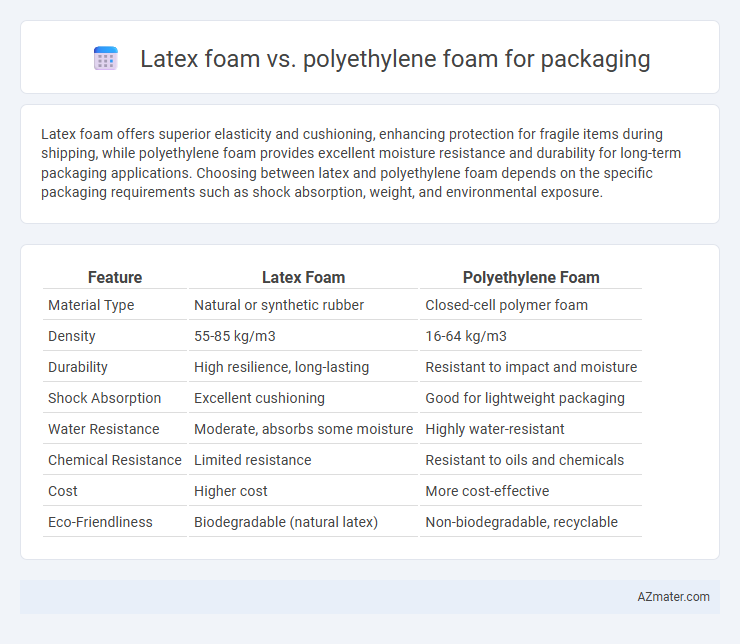Latex foam offers superior elasticity and cushioning, enhancing protection for fragile items during shipping, while polyethylene foam provides excellent moisture resistance and durability for long-term packaging applications. Choosing between latex and polyethylene foam depends on the specific packaging requirements such as shock absorption, weight, and environmental exposure.
Table of Comparison
| Feature | Latex Foam | Polyethylene Foam |
|---|---|---|
| Material Type | Natural or synthetic rubber | Closed-cell polymer foam |
| Density | 55-85 kg/m3 | 16-64 kg/m3 |
| Durability | High resilience, long-lasting | Resistant to impact and moisture |
| Shock Absorption | Excellent cushioning | Good for lightweight packaging |
| Water Resistance | Moderate, absorbs some moisture | Highly water-resistant |
| Chemical Resistance | Limited resistance | Resistant to oils and chemicals |
| Cost | Higher cost | More cost-effective |
| Eco-Friendliness | Biodegradable (natural latex) | Non-biodegradable, recyclable |
Understanding Latex Foam: Composition and Properties
Latex foam, derived from natural or synthetic latex rubber, offers exceptional elasticity, resilience, and excellent shock absorption, making it ideal for protective packaging of delicate items. Its open-cell structure provides superior cushioning and breathability compared to polyethylene foam, which is denser and less flexible. Latex foam's natural resistance to mold, mildew, and chemicals enhances its durability and suitability for long-term storage and transportation of sensitive products.
What is Polyethylene Foam? Key Features Explained
Polyethylene foam is a closed-cell, lightweight, and durable cushioning material widely used in packaging for its excellent shock absorption and moisture resistance. Key features include its high tensile strength, chemical resistance, and ability to provide superior protection against impacts, making it ideal for fragile or heavy items. Unlike latex foam, polyethylene foam offers better water resistance and thermal insulation, enhancing overall packaging performance.
Durability Comparison: Latex Foam vs Polyethylene Foam
Latex foam offers exceptional durability with high resilience and resistance to tearing, making it ideal for cushioning fragile items during long-term storage or transit. Polyethylene foam provides robust impact absorption and excellent compressive strength, but it is more prone to permanent deformation under heavy loads compared to latex foam. The choice between latex and polyethylene foams depends on specific packaging needs, balancing latex's superior elasticity against polyethylene's versatility and water resistance.
Cushioning Performance: Which Foam Offers Better Protection?
Latex foam provides superior cushioning performance in packaging due to its excellent elasticity and resilience, effectively absorbing shocks and reducing impact forces on fragile items. Polyethylene foam offers good impact resistance but is less adaptable to dynamic forces compared to latex, making it less ideal for delicate or high-value products. The choice between latex and polyethylene foam depends on the level of protection required, with latex foam generally offering better protection for sensitive goods.
Environmental Impact: Latex vs Polyethylene in Packaging
Latex foam is a biodegradable material derived from natural rubber, making it an eco-friendly option with minimal environmental impact during disposal. Polyethylene foam, a petroleum-based plastic, is non-biodegradable and contributes significantly to landfill waste and environmental pollution. Choosing latex foam over polyethylene foam in packaging reduces carbon footprint and supports sustainable waste management practices.
Cost Analysis: Evaluating Price Differences
Latex foam typically costs more than polyethylene foam due to its natural material composition and higher manufacturing expenses. Polyethylene foam offers a budget-friendly packaging solution with lower production costs and consistent pricing. Businesses prioritize polyethylene foam for large-scale packaging projects to achieve cost efficiency without compromising basic protective qualities.
Customization and Versatility for Packaging Needs
Latex foam offers superior customization due to its flexible density and resilience, making it ideal for delicate or irregularly shaped items requiring tailored cushioning. Polyethylene foam provides excellent versatility with its broad range of thicknesses and closed-cell structure, offering moisture resistance and impact protection for diverse packaging applications. Both materials support customization, but latex foam excels in conforming to intricate shapes, while polyethylene foam is preferred for durable, protective packaging solutions.
Moisture and Chemical Resistance: Head-to-Head
Latex foam offers moderate moisture resistance but tends to absorb water over time, making it less ideal for packaging products exposed to high humidity or liquids. Polyethylene foam excels in moisture resistance due to its closed-cell structure, preventing water penetration and providing superior protection for sensitive items. Chemically, polyethylene foam resists acids, bases, and solvents better than latex foam, which can degrade when exposed to harsh chemicals, impacting packaging durability.
Common Packaging Applications for Each Foam
Latex foam, known for its cushioning and shock absorption properties, is commonly used in packaging fragile electronics, medical devices, and delicate glassware to prevent damage during transit. Polyethylene foam is widely applied in packaging heavy machinery parts, automotive components, and consumer goods due to its high impact resistance and moisture barrier qualities. Both foams enhance product safety but are chosen based on specific protection needs and material compatibility.
Making the Right Choice: Which Foam Suits Your Packaging Requirements?
Latex foam offers superior elasticity, cushioning, and resilience, making it ideal for packaging delicate, high-value items requiring shock absorption and long-term durability. Polyethylene foam provides excellent moisture resistance, lightweight protection, and cost-effectiveness, suitable for bulk packaging of electronics, automotive parts, and industrial goods. Evaluating product fragility, environmental factors, and budget constraints ensures selecting the foam that meets specific packaging performance and sustainability needs.

Infographic: Latex foam vs Polyethylene foam for Packaging
 azmater.com
azmater.com